Intermediate reading
Download as pptx, pdf0 likes432 views
Based on the context, proliferate here means to spread or increase rapidly in number.
1 of 18
Download to read offline
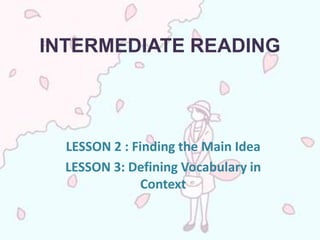
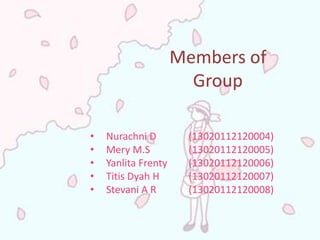
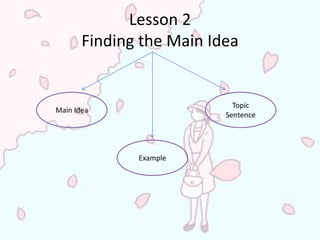
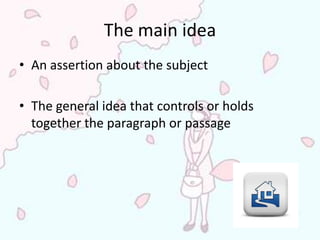
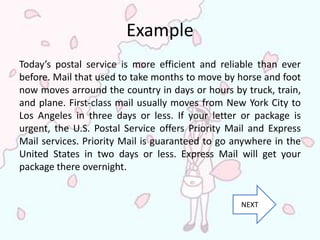



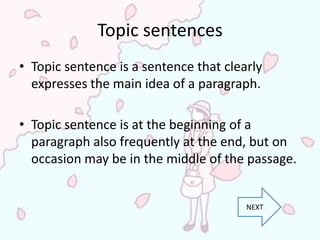
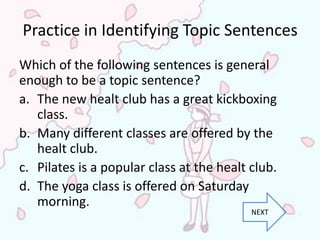
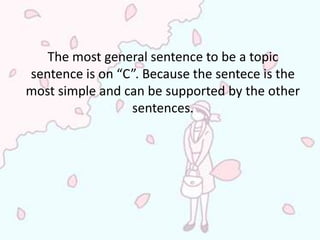
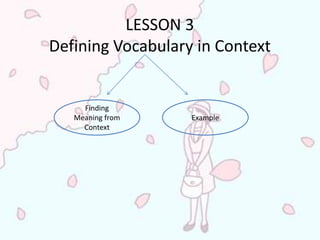




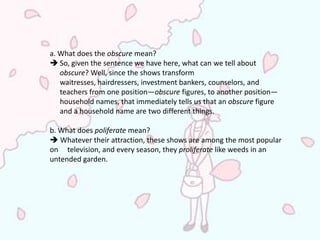

Ad
Recommended
Unit 6 - How techie are you? - 6G
Unit 6 - How techie are you? - 6Ghoangngan27
╠²
This document provides information about household appliances, phrasal verbs, and writing messages. It defines household appliances and provides examples. It discusses phrasal verbs and provides exercises to identify them. It also provides information on using "can" to make requests and ask for permission and includes exercises. The document concludes with guidance on writing informal messages, including using greetings, a body with simple grammar, and endings with your name. It includes examples of writing messages to leave for someone.Pet speaking questions with answers
Pet speaking questions with answersloe11
╠²
The document provides sample questions and answers for a PET speaking exam related to topics like home and family, hobbies, personal experiences, and interests. Some key details include:
- The student lives in Madrid in a flat near school with their parents, sister, niece, and nephew. They enjoy spending time with friends and playing sports like football.
- Their favorite city is Rome due to the abundant history, and they enjoy traveling to places around Europe on holidays.
- While they don't currently have a job, they study on weekends and enjoy subjects like English and math.
- In their free time they like watching movies, spending time with friends, and traveling. Their favorite hobby is football.IELTS Speaking Part 3.pptx
IELTS Speaking Part 3.pptxHeidiNel3
╠²
This document outlines sample questions that may be asked in Part 3 of the IELTS Speaking exam. It includes questions about eating habits, education, influences on the young, leisure activities, and the influence of television. For each topic, it provides 5 potential questions that an examiner could ask to learn more about that area. Some example questions are "How healthy is your country's food?", "What changes do you think will happen in the classroom in the near future?", and "Why do people like watching television?". The questions probe a variety of topics that could come up in everyday conversation.Lesson Plan Vocabulary 9
Lesson Plan Vocabulary 9Chad Cornwell
╠²
This lesson plan template provides guidance for a 9th grade reading lesson on climate change vocabulary. The lesson objective is for students to define content-specific vocabulary words from a climate change module by matching words to definitions, making flashcards, and assessing their knowledge levels for each word. A variety of activities are outlined, including matching vocabulary words to definitions in groups, creating individual flashcards, and a three-part vocabulary test. Student feedback and potential adjustments are also discussed.Introduction to the toeic test
Introduction to the toeic testTien Lai
╠²
The document provides an overview of the TOEIC test format and sample questions. It describes the two sections - Listening and Reading. The Listening section contains questions on photographs, question-response exchanges, and short conversations or talks. The Reading section contains incomplete sentences, text completion, and reading comprehension questions. Sample questions are provided for each format. The document also provides tips for preparing for the test, such as familiarizing oneself with the format, practicing English skills, and using online resources for test preparation materials.IELTS Speaking Part 2 - Lesson and Examples
IELTS Speaking Part 2 - Lesson and ExamplesDavid Wills
╠²
This document provides an overview of the IELTS speaking part 2 exam format. In part 2, test takers are given 1 minute to make notes on a cue card before speaking for 1-2 minutes to describe something based on the prompts. The cue card will list 3 things to talk about and a final "why" point. Test takers should speak slowly and confidently while staying on topic and within the time limit. Sample cue cards and notes are shown, as well as an example response. Partners are instructed to practice making notes and speaking in response to sample cue cards.Cambridge english exams
Cambridge english examsIrina K
╠²
This document provides information about Cambridge English language examinations and qualifications. It discusses the history and establishment of Cambridge English exams dating back to 1913. It then provides details about several specific Cambridge English exams, including the CEFR level, format, number and length of papers, and content and purpose of each paper. Exams discussed include A2 Key, B1 Preliminary, B2 First, C1 Advanced, and the Teaching Knowledge Test (TKT). Sample exam questions, tasks, and testimonials are also included to demonstrate the exams. The document is intended to inform readers about Cambridge English exams and qualifications.Complete IELTS Speaking Notes by Seema Brain Openers
Complete IELTS Speaking Notes by Seema Brain OpenersDeepak Kumar
╠²
The document provides detailed responses to common IELTS speaking questions, focusing on topics such as hometown, family, food preferences, work, and hobbies. It includes model answers that reflect both urban and rural life experiences, as well as insights into cultural and regional differences. The document aims to assist users in preparing effectively for the IELTS speaking test by demonstrating suitable language usage and structure.Pet writing part3
Pet writing part3Jose Canet
╠²
This document contains model answers for writing letters in response to parts of letters received from an English friend. The summaries are:
[1] The friend is enjoying their new karate classes but has exams coming up and needs time to study. The summary advises making a schedule to continue karate and study.
[2] The friend asks about relatives and how important they are. The summary will answer questions about relatives.
[3] The friend asks what the respondent's hometown is like and where they would like to live. The summary will answer the questions about where they live.Useful phrases for informal letters or emails
Useful phrases for informal letters or emailsiolmrue873
╠²
Starting your letter (Paragraph 1)
Lovely to hear from you. How are you? Hope you're well.
Commenting on something (Paragraph 1)
I'm sorry to hear/learn ... What wonderful news about ...
Ending your letter (Paragraph 3)
Write back soon. Looking forward to hearing from you again. Take care.Ielts speaking part 1
Ielts speaking part 1st0rmchazer
╠²
This document provides guidance and sample answers for the IELTS speaking part 1 exam. It discusses that part 1 consists of short questions about personal topics that can be answered in 1 sentence with a reason. It provides examples of common questions, sample answers, and advice like being honest if you don't know an answer. Positive and negative sample answers are given for questions about work, home, neighbors, numbers, transportation, sports and writing.Speaking a2-all-documents
Speaking a2-all-documentsCaro Mu├▒oz
╠²
The document provides an overview of the structure and implementation of a book titled "Speaking (A2 Pre-intermediate) English Readers" for teaching English speaking skills. It contains 20 units divided across 5 sections, each with the same basic structure. The structure includes sections for conversations, vocabulary practice, pronunciation, and self-assessment. Suggestions are provided for classroom activities for each section, such as role-playing conversations, improvising scenarios, games, and partner/group work to practice target language functions.Ielts mock answer key
Ielts mock answer keyDipti Srivastava
╠²
The passage is about the opening of the UK's first National Museum of Nursing in London. It provides some background about the building, which originally opened in the 19th century as the Royal Victoria Nursing College. It was considered a leading nursing college between the two World Wars. In the late 1990s it was decided to build a new college, so the building's future was uncertain until 2012 when it was converted into the National Museum of Nursing. The director is introducing the new department managers and their roles in running the museum.Preliminary English Test
Preliminary English TestNadya Sankina
╠²
The Preliminary English Test (PET) and PET for Schools are exams that assess intermediate English language ability. PET is for those wanting to improve work, study, and travel prospects and shows an understanding of instructions, conversations in work environments, and tourism. PET focuses on CEFR level B1 and tests reading, writing, speaking, listening, grammar, and vocabulary. PET for Schools is designed for school-aged learners and shows an ability to use English for everyday social and study purposes at a CEFR B1 level through assessing the same skills.DEVELOPING SPEAKING LESSON PLANS
DEVELOPING SPEAKING LESSON PLANSmarly villacrusis
╠²
This document provides guidance on developing effective speaking lesson plans. It begins by outlining the key components of a strong lesson plan, including determining the topic, objectives, activities, and assessments. It then describes various classroom activities to practice speaking skills, such as discussions, role plays, simulations, interviews and storytelling. Suggestions are made for teachers, such as providing vocabulary beforehand, limiting corrections, and giving written feedback. The conclusion emphasizes that teaching speaking requires providing opportunities for meaningful communication through engaging activities.Asking for Information about an exhibition- Role Play
Asking for Information about an exhibition- Role Playcristinaca
╠²
The document provides prompts for a phone conversation requesting information about an upcoming vintage car exhibition at The National Car Museum. The exhibition will run from July 14th to 30th and feature cars from places like Kuwait and Dubai. It will be open daily except Tuesdays from 8am to 6pm, and on Saturdays and Sunday mornings on the weekends. Adult tickets are $5 and child tickets are $3, with a 15% discount for groups of 4 or more. The nearest station is not within walking distance, but bus route 4 stops directly in front of the museum.Duolingo English Test Question Description
Duolingo English Test Question DescriptionLucia Cort├Īzar Mora
╠²
This document provides information about the different sections and question types in the Duolingo English Test. It details 12 questions that evaluate reading, listening, writing and speaking skills, including transcription of sentences, fill-in-the-blank, vocabulary recognition, image identification, short and long writing responses, and short and long speaking responses. Tips are provided for each question type.Toefl vs ielts
Toefl vs ieltsInstituteIBA
╠²
This document compares the TOEFL and IELTS English proficiency exams. Both exams test reading, listening, speaking and writing skills, but they differ in format, timing, scoring and question types. The TOEFL is available online or on paper, takes 4 hours and 10 minutes, and scores sections separately from 0-30 and the total from 0-120. The IELTS is only paper-based, takes 2 hours and 45 minutes, and provides band scores from 1-9 for each section and overall. Sample speaking questions are provided for both exams.Lecture 3 presentation skills-2
Lecture 3 presentation skills-2AzamBaloch6
╠²
The document provides tips for effective presentation skills. It discusses analyzing the audience and circumstances, planning the presentation content through brainstorming and research, writing a draft and practicing delivery. Visual aids, handling nerves, and questions are also addressed. The key points are to know your audience, thoroughly prepare the content, and rehearse the delivery through practice.─æß╗ĢI mß╗øi phŲ░ŲĪng ph├Īp dß║Īy hß╗Źc m├┤n tiß║┐ng anh
─æß╗ĢI mß╗øi phŲ░ŲĪng ph├Īp dß║Īy hß╗Źc m├┤n tiß║┐ng anhHong Phuong Nguyen
╠²
T├Āi liß╗ću nhß║źn mß║Īnh sß╗▒ cß║¦n thiß║┐t phß║Żi ─æß╗Ģi mß╗øi phŲ░ŲĪng ph├Īp dß║Īy v├Ā hß╗Źc tiß║┐ng Anh, tß║Łp trung v├Āo viß╗ćc tß║Īo hß╗®ng th├║ v├Ā cß║Żi thiß╗ćn khß║Ż n─āng tß╗▒ hß╗Źc cß╗¦a hß╗Źc sinh. C├Īc gi├Īo vi├¬n cß║¦n ─æiß╗üu chß╗ēnh phŲ░ŲĪng ph├Īp dß║Īy hß╗Źc, kiß╗ām tra v├Ā hß╗Ś trß╗Ż hß╗Źc sinh mß╗Öt c├Īch linh hoß║Īt v├Ā c├┤ng bß║▒ng, ─æß╗ōng thß╗Øi khuyß║┐n kh├Łch hoß║Īt ─æß╗Öng ngo├Āi giß╗Ø ─æß╗ā n├óng cao kß╗╣ n─āng ng├┤n ngß╗». Kß║┐t luß║Łn cho rß║▒ng ─æß╗Ģi mß╗øi kh├┤ng chß╗ē l├Ā phŲ░ŲĪng ph├Īp m├Ā c├▓n l├Ā c├Īch tiß║┐p cß║Łn nhß║▒m ph├Īt huy sß╗▒ chß╗¦ ─æß╗Öng v├Ā s├Īng tß║Īo trong hß╗Źc tß║Łp.Chapter 3 (use language that makes your messages memorable)
Chapter 3 (use language that makes your messages memorable)metalkid132
╠²
This document provides tips for making messages memorable through language use. It discusses using vivid words and sentences, clarifying general statements with specifics, and emphasizing key points through proportion of time, repetition, and transitions. Storytelling and marketing messages can be made more memorable by developing stories with purpose, audience understanding, conflict and resolution. The 4C model of comprehension, connection, credibility, and contagiousness can also help craft memorable messages.Thesis Writing A Comprehensive set of guidelines
Thesis Writing A Comprehensive set of guidelines Eugenelees
╠²
This document provides comprehensive guidelines on writing a thesis statement, defining it as the main idea or central purpose of an essay. It discusses the importance of clarity, specificity, and singular focus in crafting an effective thesis statement, along with common issues encountered in identifying them. Additionally, it includes practice exercises and examples to help strengthen thesis writing skills.Thesis statement ppt
Thesis statement pptjohnarunski
╠²
Cats should be subject to leash laws because as natural wanderers they pose risks to local wildlife populations and safety hazards in areas with vehicle traffic.Q4 WEEK 1 JUDGE THE RELEVANCE AND WORTH OF IDEAS.pptx
Q4 WEEK 1 JUDGE THE RELEVANCE AND WORTH OF IDEAS.pptxAishaLizabelleLirado
╠²
The document discusses judging the relevance and worth of ideas. It defines relevance as having a significant and demonstrable bearing on the matter at hand. The document contains examples of relevant and irrelevant ideas in different contexts. It emphasizes the importance of considering relevance when evaluating ideas.elephant in my heart want to be bited in my heart
elephant in my heart want to be bited in my heartBellalaAshruth
╠²
The document outlines essential writing techniques, emphasizing the importance of adaptation to reader understanding through careful word choice and simplification. It highlights key practices such as using familiar and concrete words, favoring active voice over passive voice, and avoiding jargon unless explained. The guidelines also cover grammatical rules, punctuation, and editing strategies to enhance clarity and effectiveness in writing.Lesson-4 _ Thesis-Statement.pptx
Lesson-4 _ Thesis-Statement.pptxJunrexManulatPerez
╠²
The document outlines the essential elements of a thesis statement, emphasizing that it should be a complete, declarative sentence that encapsulates the main idea of an essay. It provides examples of poor and improved thesis statements, along with guidelines for crafting effective ones. Additionally, it includes exercises to practice identifying the quality of various thesis statements and evaluating their effectiveness.ENGLISH WEEK 1
ENGLISH WEEK 1Venus Patual
╠²
The document outlines a multi-day lesson plan focused on adjectives, their types, and their usage in sentences, including activities such as group discussions and work on constructing sentences. It also includes rules for subject-verb agreement, the structure of paragraphs, and the use of a 'hamburger' analogy to demonstrate paragraph organization. Various tasks are assigned to engage students in both individual and collaborative learning experiences.Argumentative essay
Argumentative essayAnis Zulaikha
╠²
The document outlines guidelines for writing an argumentative essay, detailing how to choose a position, support it with relevant examples, and use common phrases. Key topics suggested include opinions on education, financial wealth, and lifestyle choices, emphasizing the importance of structure, including thesis statements and topic sentences. It also includes various exercises for organizing ideas and drafting an effective introduction.Using context clues workshop days 1-3
Using context clues workshop days 1-3LizzieRogers3
╠²
This document provides strategies and examples for determining the meaning of unknown words using context clues. It discusses 9 different strategies:
1. A sentence may contain the definition of the word.
2. Additional context helps understand the word's meaning even without an explicit definition.
3. Unknown words can be understood by their relationship to known synonyms or antonyms.
4. Prior knowledge about a topic can provide context for understanding a word.
5. Word roots, prefixes and suffixes provide clues to a word's meaning.
6. A word's part of speech provides limitations on possible meanings.
7. Punctuation like commas and semicolons can indicate definitions or explanations. Thesis Statement on various Academic Text.pptx
Thesis Statement on various Academic Text.pptxRubenAgacio
╠²
This document provides information and guidance on writing effective thesis statements. It defines what a thesis statement is and discusses key characteristics of a good thesis statement, including that it should be focused, have a clear position or argument, and avoid being too broad, wordy, general, or a simple fact or title. The document also provides examples of strong and weak thesis statements and has the reader practice identifying good and bad thesis statements. It concludes by walking the reader through writing their own thesis statement on a given topic.More Related Content
What's hot (12)
Pet writing part3
Pet writing part3Jose Canet
╠²
This document contains model answers for writing letters in response to parts of letters received from an English friend. The summaries are:
[1] The friend is enjoying their new karate classes but has exams coming up and needs time to study. The summary advises making a schedule to continue karate and study.
[2] The friend asks about relatives and how important they are. The summary will answer questions about relatives.
[3] The friend asks what the respondent's hometown is like and where they would like to live. The summary will answer the questions about where they live.Useful phrases for informal letters or emails
Useful phrases for informal letters or emailsiolmrue873
╠²
Starting your letter (Paragraph 1)
Lovely to hear from you. How are you? Hope you're well.
Commenting on something (Paragraph 1)
I'm sorry to hear/learn ... What wonderful news about ...
Ending your letter (Paragraph 3)
Write back soon. Looking forward to hearing from you again. Take care.Ielts speaking part 1
Ielts speaking part 1st0rmchazer
╠²
This document provides guidance and sample answers for the IELTS speaking part 1 exam. It discusses that part 1 consists of short questions about personal topics that can be answered in 1 sentence with a reason. It provides examples of common questions, sample answers, and advice like being honest if you don't know an answer. Positive and negative sample answers are given for questions about work, home, neighbors, numbers, transportation, sports and writing.Speaking a2-all-documents
Speaking a2-all-documentsCaro Mu├▒oz
╠²
The document provides an overview of the structure and implementation of a book titled "Speaking (A2 Pre-intermediate) English Readers" for teaching English speaking skills. It contains 20 units divided across 5 sections, each with the same basic structure. The structure includes sections for conversations, vocabulary practice, pronunciation, and self-assessment. Suggestions are provided for classroom activities for each section, such as role-playing conversations, improvising scenarios, games, and partner/group work to practice target language functions.Ielts mock answer key
Ielts mock answer keyDipti Srivastava
╠²
The passage is about the opening of the UK's first National Museum of Nursing in London. It provides some background about the building, which originally opened in the 19th century as the Royal Victoria Nursing College. It was considered a leading nursing college between the two World Wars. In the late 1990s it was decided to build a new college, so the building's future was uncertain until 2012 when it was converted into the National Museum of Nursing. The director is introducing the new department managers and their roles in running the museum.Preliminary English Test
Preliminary English TestNadya Sankina
╠²
The Preliminary English Test (PET) and PET for Schools are exams that assess intermediate English language ability. PET is for those wanting to improve work, study, and travel prospects and shows an understanding of instructions, conversations in work environments, and tourism. PET focuses on CEFR level B1 and tests reading, writing, speaking, listening, grammar, and vocabulary. PET for Schools is designed for school-aged learners and shows an ability to use English for everyday social and study purposes at a CEFR B1 level through assessing the same skills.DEVELOPING SPEAKING LESSON PLANS
DEVELOPING SPEAKING LESSON PLANSmarly villacrusis
╠²
This document provides guidance on developing effective speaking lesson plans. It begins by outlining the key components of a strong lesson plan, including determining the topic, objectives, activities, and assessments. It then describes various classroom activities to practice speaking skills, such as discussions, role plays, simulations, interviews and storytelling. Suggestions are made for teachers, such as providing vocabulary beforehand, limiting corrections, and giving written feedback. The conclusion emphasizes that teaching speaking requires providing opportunities for meaningful communication through engaging activities.Asking for Information about an exhibition- Role Play
Asking for Information about an exhibition- Role Playcristinaca
╠²
The document provides prompts for a phone conversation requesting information about an upcoming vintage car exhibition at The National Car Museum. The exhibition will run from July 14th to 30th and feature cars from places like Kuwait and Dubai. It will be open daily except Tuesdays from 8am to 6pm, and on Saturdays and Sunday mornings on the weekends. Adult tickets are $5 and child tickets are $3, with a 15% discount for groups of 4 or more. The nearest station is not within walking distance, but bus route 4 stops directly in front of the museum.Duolingo English Test Question Description
Duolingo English Test Question DescriptionLucia Cort├Īzar Mora
╠²
This document provides information about the different sections and question types in the Duolingo English Test. It details 12 questions that evaluate reading, listening, writing and speaking skills, including transcription of sentences, fill-in-the-blank, vocabulary recognition, image identification, short and long writing responses, and short and long speaking responses. Tips are provided for each question type.Toefl vs ielts
Toefl vs ieltsInstituteIBA
╠²
This document compares the TOEFL and IELTS English proficiency exams. Both exams test reading, listening, speaking and writing skills, but they differ in format, timing, scoring and question types. The TOEFL is available online or on paper, takes 4 hours and 10 minutes, and scores sections separately from 0-30 and the total from 0-120. The IELTS is only paper-based, takes 2 hours and 45 minutes, and provides band scores from 1-9 for each section and overall. Sample speaking questions are provided for both exams.Lecture 3 presentation skills-2
Lecture 3 presentation skills-2AzamBaloch6
╠²
The document provides tips for effective presentation skills. It discusses analyzing the audience and circumstances, planning the presentation content through brainstorming and research, writing a draft and practicing delivery. Visual aids, handling nerves, and questions are also addressed. The key points are to know your audience, thoroughly prepare the content, and rehearse the delivery through practice.─æß╗ĢI mß╗øi phŲ░ŲĪng ph├Īp dß║Īy hß╗Źc m├┤n tiß║┐ng anh
─æß╗ĢI mß╗øi phŲ░ŲĪng ph├Īp dß║Īy hß╗Źc m├┤n tiß║┐ng anhHong Phuong Nguyen
╠²
T├Āi liß╗ću nhß║źn mß║Īnh sß╗▒ cß║¦n thiß║┐t phß║Żi ─æß╗Ģi mß╗øi phŲ░ŲĪng ph├Īp dß║Īy v├Ā hß╗Źc tiß║┐ng Anh, tß║Łp trung v├Āo viß╗ćc tß║Īo hß╗®ng th├║ v├Ā cß║Żi thiß╗ćn khß║Ż n─āng tß╗▒ hß╗Źc cß╗¦a hß╗Źc sinh. C├Īc gi├Īo vi├¬n cß║¦n ─æiß╗üu chß╗ēnh phŲ░ŲĪng ph├Īp dß║Īy hß╗Źc, kiß╗ām tra v├Ā hß╗Ś trß╗Ż hß╗Źc sinh mß╗Öt c├Īch linh hoß║Īt v├Ā c├┤ng bß║▒ng, ─æß╗ōng thß╗Øi khuyß║┐n kh├Łch hoß║Īt ─æß╗Öng ngo├Āi giß╗Ø ─æß╗ā n├óng cao kß╗╣ n─āng ng├┤n ngß╗». Kß║┐t luß║Łn cho rß║▒ng ─æß╗Ģi mß╗øi kh├┤ng chß╗ē l├Ā phŲ░ŲĪng ph├Īp m├Ā c├▓n l├Ā c├Īch tiß║┐p cß║Łn nhß║▒m ph├Īt huy sß╗▒ chß╗¦ ─æß╗Öng v├Ā s├Īng tß║Īo trong hß╗Źc tß║Łp.Similar to Intermediate reading (20)
Chapter 3 (use language that makes your messages memorable)
Chapter 3 (use language that makes your messages memorable)metalkid132
╠²
This document provides tips for making messages memorable through language use. It discusses using vivid words and sentences, clarifying general statements with specifics, and emphasizing key points through proportion of time, repetition, and transitions. Storytelling and marketing messages can be made more memorable by developing stories with purpose, audience understanding, conflict and resolution. The 4C model of comprehension, connection, credibility, and contagiousness can also help craft memorable messages.Thesis Writing A Comprehensive set of guidelines
Thesis Writing A Comprehensive set of guidelines Eugenelees
╠²
This document provides comprehensive guidelines on writing a thesis statement, defining it as the main idea or central purpose of an essay. It discusses the importance of clarity, specificity, and singular focus in crafting an effective thesis statement, along with common issues encountered in identifying them. Additionally, it includes practice exercises and examples to help strengthen thesis writing skills.Thesis statement ppt
Thesis statement pptjohnarunski
╠²
Cats should be subject to leash laws because as natural wanderers they pose risks to local wildlife populations and safety hazards in areas with vehicle traffic.Q4 WEEK 1 JUDGE THE RELEVANCE AND WORTH OF IDEAS.pptx
Q4 WEEK 1 JUDGE THE RELEVANCE AND WORTH OF IDEAS.pptxAishaLizabelleLirado
╠²
The document discusses judging the relevance and worth of ideas. It defines relevance as having a significant and demonstrable bearing on the matter at hand. The document contains examples of relevant and irrelevant ideas in different contexts. It emphasizes the importance of considering relevance when evaluating ideas.elephant in my heart want to be bited in my heart
elephant in my heart want to be bited in my heartBellalaAshruth
╠²
The document outlines essential writing techniques, emphasizing the importance of adaptation to reader understanding through careful word choice and simplification. It highlights key practices such as using familiar and concrete words, favoring active voice over passive voice, and avoiding jargon unless explained. The guidelines also cover grammatical rules, punctuation, and editing strategies to enhance clarity and effectiveness in writing.Lesson-4 _ Thesis-Statement.pptx
Lesson-4 _ Thesis-Statement.pptxJunrexManulatPerez
╠²
The document outlines the essential elements of a thesis statement, emphasizing that it should be a complete, declarative sentence that encapsulates the main idea of an essay. It provides examples of poor and improved thesis statements, along with guidelines for crafting effective ones. Additionally, it includes exercises to practice identifying the quality of various thesis statements and evaluating their effectiveness.ENGLISH WEEK 1
ENGLISH WEEK 1Venus Patual
╠²
The document outlines a multi-day lesson plan focused on adjectives, their types, and their usage in sentences, including activities such as group discussions and work on constructing sentences. It also includes rules for subject-verb agreement, the structure of paragraphs, and the use of a 'hamburger' analogy to demonstrate paragraph organization. Various tasks are assigned to engage students in both individual and collaborative learning experiences.Argumentative essay
Argumentative essayAnis Zulaikha
╠²
The document outlines guidelines for writing an argumentative essay, detailing how to choose a position, support it with relevant examples, and use common phrases. Key topics suggested include opinions on education, financial wealth, and lifestyle choices, emphasizing the importance of structure, including thesis statements and topic sentences. It also includes various exercises for organizing ideas and drafting an effective introduction.Using context clues workshop days 1-3
Using context clues workshop days 1-3LizzieRogers3
╠²
This document provides strategies and examples for determining the meaning of unknown words using context clues. It discusses 9 different strategies:
1. A sentence may contain the definition of the word.
2. Additional context helps understand the word's meaning even without an explicit definition.
3. Unknown words can be understood by their relationship to known synonyms or antonyms.
4. Prior knowledge about a topic can provide context for understanding a word.
5. Word roots, prefixes and suffixes provide clues to a word's meaning.
6. A word's part of speech provides limitations on possible meanings.
7. Punctuation like commas and semicolons can indicate definitions or explanations. Thesis Statement on various Academic Text.pptx
Thesis Statement on various Academic Text.pptxRubenAgacio
╠²
This document provides information and guidance on writing effective thesis statements. It defines what a thesis statement is and discusses key characteristics of a good thesis statement, including that it should be focused, have a clear position or argument, and avoid being too broad, wordy, general, or a simple fact or title. The document also provides examples of strong and weak thesis statements and has the reader practice identifying good and bad thesis statements. It concludes by walking the reader through writing their own thesis statement on a given topic.Reading skills
Reading skillsWarriors Zone
╠²
Here are 3 reading comprehension questions for you to answer on your own:
1. Passage: Most people enjoy spending time outside on nice days. Activities like going to the park, beach, or hiking trails allow individuals to experience nature and get fresh air and exercise.
Question: What is this passage mostly about?
2. Passage: John was excited to go camping for the weekend. He packed his tent, sleeping bag, flashlight, and other essential gear. After a few hours of driving, he arrived at the campsite in the woods by the lake. It was getting dark, so he set up his tent and started a small campfire.
Question: Where did John go camping?
3EAPP Q1 WEEK LESSON THESIS STATEMENT.pptx
EAPP Q1 WEEK LESSON THESIS STATEMENT.pptxrobskyyy25
╠²
The document outlines the importance of developing a strong thesis statement for various types of writing. It explains the essential elements of a thesis statement, provides multiple examples, and offers techniques for identifying and crafting effective thesis statements. Additionally, it presents activities and questions to enhance understanding of thesis construction and evaluation.The learner realizes that information in a written text may be selected an...
The learner realizes that information in a written text may be selected an...Manong Mele
╠²
The document discusses the concept of discourse analysis, differentiating between text and discourse while exploring various types of discourse, such as argumentation, description, exposition, and narration. It emphasizes the importance of context, culture, and social environment in shaping a writer's perspective and highlights the necessity of coherence and cohesion for constructing well-written texts. Additionally, it provides examples, mistakes to avoid, and activities to reinforce understanding of these concepts.Writer's Voice
Writer's VoiceJustineWhite6
╠²
The document explores the concept of a writer's voice, highlighting the importance of tone, word choice, and style in creating distinct voices. It includes examples and exercises to help readers practice identifying tones in writing and emphasizes the development of one's voice through regular reading and writing. The document suggests that attention to detail in grammar and strong descriptive language is essential for conveying a unique writer's voice.Class 17 raw
Class 17 rawkimpalmore
╠²
This document provides instructions for an upcoming essay assignment. Students will write a 5-7 page essay proposing a solution to an education problem. They have been working on brainstorming solutions in previous assignments. The document reviews the essay prompt, timeline, and criteria. It also provides guidance on refining a solution, including exploring multiple options and explaining how the chosen solution would work and be implemented. Students are reminded to identify any additional research needed to support their arguments. The next class will be held at the library to begin this research.Thesis statement subtopics and location
Thesis statement subtopics and locationmisterbatroms
╠²
The document discusses key features of a thesis statement, including its typical location and use of subtopics. A thesis statement is usually found at the end of the introductory paragraph and often lists the subtopics that will be discussed in the essay. It provides examples of effective thesis statements that include three subtopics each. Thesis statements help inform the reader of what to expect to be covered in the body paragraphs.Course 2 workshop 3 week 5
Course 2 workshop 3 week 5tiffanysue345
╠²
This document provides an agenda and lesson plans for a workshop on natural disasters. It includes the following:
- An agenda for Monday including turning in homework passes, watching announcements and a news program, reviewing expectations, and participating in seminar activities.
- Agendas for subsequent days of the week focused on points of view, editorials, vocabulary, and reading assignments.
- Details on lessons covering analyzing points of view, interpreting figures of speech, reading response journals, analyzing editorial cartoons, and creating their own cartoons.
- The learning targets and schedules for the rest of the workshop week.Writing A Good Essay Intro - Basics Of Research Paper Writi
Writing A Good Essay Intro - Basics Of Research Paper WritiPamela Caluso
╠²
The document provides instructions for creating an account and submitting assignment requests on the HelpWriting.net website. It outlines a 5-step process: 1) Create an account with an email and password. 2) Complete an order form with instructions, sources, and deadline. 3) Review bids from writers and select one. 4) Review the completed paper and authorize payment. 5) Request revisions until satisfied.D17-EWRT 1A
D17-EWRT 1ABrian Malone
╠²
The document provides instructions for revising Essay #1 or #2 for the EWRT 1A class. Revisions are due by March 19th at 6 AM. Students may only submit one revised essay. If a student did not submit one of the first two essays, they can submit it as their revision. Students should make an appointment if they want to discuss their revision with the instructor. The instructor will grade revisions like new submissions and replace the original grade. No late revisions will be accepted.Ad
Intermediate reading
- 1. INTERMEDIATE READING LESSON 2 : Finding the Main Idea LESSON 3: Defining Vocabulary in Context
- 2. Members of Group ŌĆó Nurachni D (13020112120004) ŌĆó Mery M.S (13020112120005) ŌĆó Yanlita Frenty (13020112120006) ŌĆó Titis Dyah H (13020112120007) ŌĆó Stevani A R (13020112120008)
- 3. Lesson 2 Finding the Main Idea Topic Main Idea Sentence Example
- 4. The main idea ŌĆó An assertion about the subject ŌĆó The general idea that controls or holds together the paragraph or passage
- 5. Example TodayŌĆÖs postal service is more efficient and reliable than ever before. Mail that used to take months to move by horse and foot now moves arround the country in days or hours by truck, train, and plane. First-class mail usually moves from New York City to Los Angeles in three days or less. If your letter or package is urgent, the U.S. Postal Service offers Priority Mail and Express Mail services. Priority Mail is guaranteed to go anywhere in the United States in two days or less. Express Mail will get your package there overnight. NEXT
- 6. Which of the following sentences best summarizes the main idea of the passage? a. Express Mail is good way to send urgent mail. b. Mail service today is more effective and dependable c. First-class mail usually takes three days or less. NEXT
- 7. a. Express Mail is a good way to send urgent mail answer a is specific, cannot be the main idea c. First-class mail usually takes there days or less answer c is also very spesific, cannot be the main idea NEXT
- 8. b. Mail service today is more effective and dependable answer b is general enough to encompass the whole passage
- 9. Topic sentences ŌĆó Topic sentence is a sentence that clearly expresses the main idea of a paragraph. ŌĆó Topic sentence is at the beginning of a paragraph also frequently at the end, but on occasion may be in the middle of the passage. NEXT
- 10. Practice in Identifying Topic Sentences Which of the following sentences is general enough to be a topic sentence? a. The new healt club has a great kickboxing class. b. Many different classes are offered by the healt club. c. Pilates is a popular class at the healt club. d. The yoga class is offered on Saturday morning. NEXT
- 11. The most general sentence to be a topic sentence is on ŌĆ£CŌĆØ. Because the sentece is the most simple and can be supported by the other sentences.
- 12. LESSON 3 Defining Vocabulary in Context Finding Meaning from Example Context
- 13. Finding Meaning from Context ŌĆó Sometimes in the passage, there are some words or phrases that are unfamiliar for us. ŌĆó If we have a dictionary to look up the meaning of the words, it doesnŌĆÖt matter. But if we donŌĆÖt have any dictionary we can use the context to help us determine the meaning. NEXT
- 14. ŌĆó If we do a little detective work, we can determine their definition by looking carefully at how they are used in paragraph. ŌĆó By examining the words and ideas surrounding it, we will know about the word by how it is used. ŌĆó This is called determining word meaning through context. ŌĆó Like detectives looking for clues at a crime scene, we must look at the passage for clues that will help us define this word. NEXT
- 15. ŌĆó The ability to determine the meaning of unfamiliar words from their context is an essential skill for reading comperehension. ŌĆó Sometimes there will be unfamiliar words whose meaning we canŌĆÖt determine without a dictionary. ŌĆó But more often than not, a careful look at the context will give you enough clues to meaning.
- 16. Example Most reality TV shows center on two common motivators: fame and money. The shows transform waitresses, hairdressers, investment bankers, counselors, and teachers, to name a few, from obscure figures to household names. A lucky few successfully parlay their 15 minutes of fame into celebrity. Even if you are not interested in fame, you can probably understand the desire for lots of money. Watching people eat large insects, reveal their innermost thoughts to millions of people, and allow themselves to be filmed 24 hours a day for a huge financial reward makes for interesting viewing.Whatever their attraction, these shows are among the most popular on television, and every season, they proliferate like weeds in an untended garden. The networks are quickly replacing more traditional dramas and comedies with reality TV programs, which earn millions in advertising revenue.Whether you love it or hate it, one thing is for sureŌĆö reality TV is here to stay! NEXT
- 17. a. What does the obscure mean? ’ā© So, given the sentence we have here, what can we tell about obscure? Well, since the shows transform waitresses, hairdressers, investment bankers, counselors, and teachers from one positionŌĆöobscure figures, to another positionŌĆö household names, that immediately tells us that an obscure figure and a household name are two different things. b. What does poliferate mean? ’ā© Whatever their attraction, these shows are among the most popular on television, and every season, they proliferate like weeds in an untended garden.
